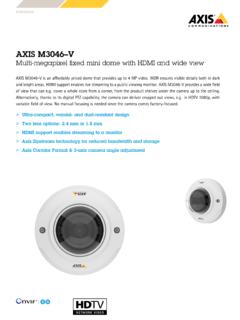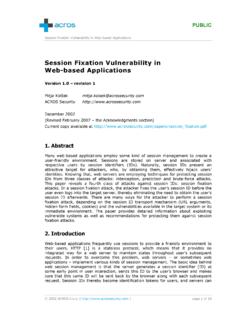Transcription of SIP – An introduction
1 White paperSIP An introduction Table of contents1 Introducing SIP 32 How does it work? 33 Inside a normal SIP call 44 DTMF sending commands in sip calls 65 Complex environments and higher security 66 Summary 77 The SIP dictionary 831. Introducing SIPS ession Initiation Protocol (SIP) is used to initiate, maintain and terminate multimedia sessions between different parties.
2 Usually these sessions consist of audio, but sometimes they consist of video. SIP is the standard protocol used in Voice over IP (VoIP) applications and unified communication is for example supported by AXIS C3003-E Network Horn Speaker and AXIS A8004-VE Network Video Door Station and constitute a new way to connect, integrate and control your Axis network How does it work?In order to communicate using SIP at least two SIP clients are needed. A SIP client can be a SIP hard-phone, softphone, mobile client or SIP enabled Axis SIP client is assigned its own SIP address. A SIP address looks like an email address with a sip: prefix, for example, This identifier can be used across a number of devices and is analogous to the use of a telephone number linked to a SIM card that can be used in a number of Peer-to-peer setup the simple wayA SIP system can take many forms.
3 In its simplest form, the system consists of two or more SIP User Agents (UA) communicating directly with each other. This can be called a peer-to-peer setup, a direct call setup or local setup. A typical SIP address in this case would look like sip:<local-ip>, for example, order to make a peer-to-peer call from one UA to another on a local network all that is needed is the SIP address containing the unit s IP address. Note that not all SIP clients support peer-to-peer Using a SIP server (PBX) adding more possibilitiesA SIP-based VoIP infrastructure scales very well. The next step up in size is to use a registrar, Private Branch Exchange (PBX) or SIP server, as a central hub.
4 The SIP UAs register with the registrar and can then reach each other s SIP UAs simply by dialling an extension on the PBX. A typical SIP address in this case would look like sip:<user>@<domain> or sip:<user>@<registrar-ip> such as A PBX works like a traditional switchboard, showing the clients current status, allowing call transfers, voicemail, redirections and much SIP server usually includes proxy, registrar and redirect functionality. Proxies route calls and provide additional logic to incoming calls. Registrars accept register requests and act as a location service for the domain that it handles. Redirect servers redirect the client to contact an alternative SIP *0#User Agent BSIP Enabled PhoneVideo management SoftwareSIP Adress: Agent AAXIS A8004-VEUser Agent CAXIS C3003-ESIP Adress: Adress: / VAPIXSIPE xample: In a simple setup the Axis products can use SIP for setting up audio and/or video communication with other SIP devices on the same network, without having a server or the same time they can be connected as any other Axis device to the video management system using the open APIs VAPIX or ONVIF Profile S.
5 4 The SIP server can be set up as a local entity or it can be located offsite. It can be hosted on an intranet or it can be hosted by a third party provider. When making SIP calls across sites, calls are normally initially routed through a set of SIP proxies. These proxies query the location of the SIP address to be order to use your device with a SIP server you need to create an account on the server with a specified user ID and password. To register your device to the server, you need to set up an account on the device entering the server address, user ID and Using SIP trunks assigning a telephone numberUsing a SIP trunk, SIP UAs can even be switched to the traditional analog telephone network (PSTN).
6 This way you can assign a traditional telephone number to the SIP used with a SIP trunk the device connects to the server in the way described above. The service provider will usually charge extra for external Inside a normal SIP callIn order to make a SIP call a sequence of steps are performed to exchange information between the UA initiating and receiving the initiating a call, the initiator sends a request or an INVITE to the recipient s SIP address. The IN-VITE contains a Session Description Protocol (SDP) body describing the media formats available and contact information for the initiator of the *0#User Agent AAXIS A8004-VEUser Agent BSIP Enabled PhonePBXSIP ServerUser Agent CAXIS C3003-ESIP Agent AAXIS A8004-VEPhoneNormal PhoneSIP TrunkSIP ProviderUser Agent CAXIS number:1-800-1234-501 Phone number:1-800-1234-502 SIPSIPSIPE xample: Using a SIP trunk with a service provider you can assign an external phone number to your device.
7 This way you can make calls between a network speaker or door station and regular : Axis products can connect to a SIP server running either locally or hosted by a third-party provider. The server handles the setup and termination of calls between SIP devices on the local network or over the this setup the SIP address of the device is independent of its IP address and the SIP server makes the device accessible as long as it is registered to the receiving the INVITE, the recipient immediately acknowledges this by answering with a 100 TRYING response.
8 The receiving UA then compares the offered media formats described in the SDP with its own. If a common format can be decided, the UA alerts the recipient that there is an incoming call and sends a provisional response back to the initiating UA - 180 the recipient decides to pick up the call, a 200 OK response is sent to the initiator to confirm that a connection has been established. This response contains a negotiated SDP indicating to the initiator which media formats should be used and to where the media streams should be negotiated media streams are now set up using the Real-time Transport Protocol (RTP) with parameters based on the negotiated SDP and the media travels directly between the two parties.
9 The initiator sends an acknowledgement (ACK) via SIP to acknowledge that it has set up the media streams as agreed. The SIP session is still active but it is no longer involved in the media one of the parties decides to end the call, it sends a new request BYE. Upon receiving a BYE, the receiving party acknowledges this with a 200 OK and the RTP media streams are then SDP negotiating what format is usedSession Description Protocol (SDP) is a format for describing streaming media initialization parameters. The SDP body contains information about which media formats (that is, codecs) are supported by the clients and the clients preferred codec selection order.
10 Typical audio codecs used for SIP calls are PCMU, PCMA, , and L16. If multiple overlapping codecs are supported by both the initiator and the recipient, the codec with the highest priority on the recipient side will normally be selected. The choice of codecs ultimately affects the bandwidth so careful consideration should be taken to meet compatibility require-ments to other SIP UAs and to maintain a bandwidth requirement that suits the use case. For example, in a local network where all clients support L16, the choice of uncompressed audio works well. However, if the SIP UA is to be accessed via the Internet through a 3G mobile phone, PCMU is be a better Calls in complex SIP infrastructuresIn a more complex SIP infrastructure setup, the initiation looks a bit different as the SIP session is set up step-by-step for each hop.
















